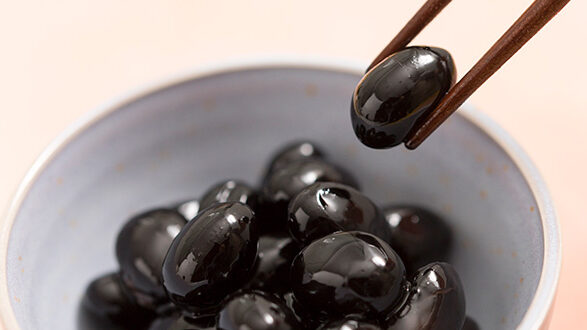
When you think of Kyoto, you might picture serene temples and delicate sweets. But there’s also a hearty, traditional dish that’s especially important during the New Year celebrations: “Kuromame-ni,” or simmered black soybeans. These aren’t just any black soybeans; they’re often the prized Tanba black soybeans from the Kyoto region, known for their large size and rich flavor. Simmered to a tender, slightly sweet perfection in soy sauce and sugar, Kuromame-ni carries wishes for good health and diligence in the year to come. It’s a simple yet deeply symbolic part of Kyoto’s culinary heritage.
Dish Name: Kuromame-ni
- Region / Location: Kyoto Prefecture
- Primary Area of Tradition: Nantan, Chutan, and Tango regions
- Main Ingredients: Tanba black soybeans, sugar, soy sauce, etc.
How It’s Eaten / Served
Kuromame-ni is typically served as part of the “Osechi Ryori,” the special New Year’s feast in Japan. The simmered black soybeans are placed in small bowls and eaten as is. The slow simmering process over low heat makes the beans plump and incredibly delicious.
Cultural Background and Preservation
Black soybeans have a long history in Japan, mentioned as one of the five grains as early as the Nara period (710-794 AD). The specific “Tanba black soybean” from the Tanba region of Kyoto Prefecture, known for its large size and intense flavor due to the fertile soil and significant temperature differences between day and night, has been cultivated for centuries. Records from the 10th century distinguish “black beans” from regular soybeans, and by the 16th century, they were even presented as offerings to the Imperial Court, suggesting widespread cultivation. Due to the long six-month growing period and the demanding cultivation techniques, they were sometimes referred to as “kuro-mame” (苦労豆), meaning “hardship beans” by the producers. The glossy, jet-black appearance and the delicious taste after simmering make them highly valued. While younger green soybeans are enjoyed as edamame or in rice, the simmered black soybeans, Kuromame-ni, are an indispensable part of the New Year’s Osechi Ryori, symbolizing a wish for good health and the ability to work diligently. Beyond New Year’s, Kuromame-ni and black bean rice are enjoyed throughout the year. Local elementary schools even incorporate Kuromame-ni into cooking classes and New Year’s school lunches. In recent years, innovative recipes using black soybeans have emerged, including sweets and tofu, further ensuring the preservation and appreciation of this local specialty.
Additional information:
- Tanba (丹波): A region spanning parts of Kyoto and Hyogo prefectures, known for its high-quality agricultural products, including black soybeans.
- Osechi Ryori (おせち料理): Traditional Japanese New Year’s food, carefully prepared in advance and packed in special lacquered boxes. Each dish in Osechi Ryori has a symbolic meaning, representing wishes for health, prosperity, and happiness in the new year.
- Edamame (枝豆): Young soybeans in their pods, typically boiled or steamed and served as a snack.
The information about regional cuisine featured on this website (Piggy's Grandma of Japan) is summarized and adapted from the Ministry of Agriculture, Forestry and Fisheries of Japan (MAFF) website, "Our Regional Cuisines"Additional commentary is provided based on the unique experiences and perspectives of the site's editors.
The copyright for the original content regarding regional cuisine belongs to the Ministry of Agriculture, Forestry and Fisheries of Japan.
The summaries and adaptations published on this site are intended for informational purposes only. Piggy's Grandma of Japan does not guarantee the accuracy or completeness of this information. For the most accurate and complete details, please refer to the original pages on the MAFF website.

